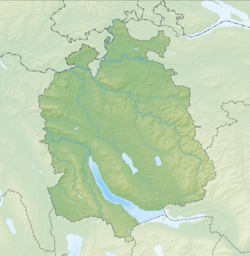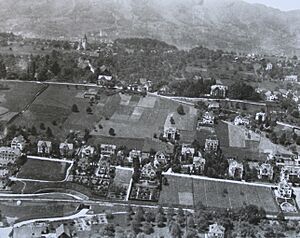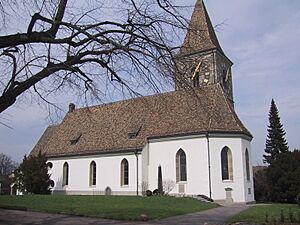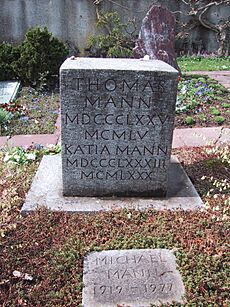Kilchberg, Zurich facts for kids
Quick facts for kids
Kilchberg
|
||
|---|---|---|
 |
||
|
||
| Country | Switzerland | |
| Canton | Zürich | |
| District | Horgen | |
| Area | ||
| • Total | 2.58 km2 (1.00 sq mi) | |
| Elevation | 510 m (1,670 ft) | |
| Population
(Dec 2020 )
|
||
| • Total | 9,207 | |
| • Density | 3,569/km2 (9,243/sq mi) | |
| Postal code |
8802
|
|
| Surrounded by | Adliswil, Küsnacht, Rüschlikon, Zollikon, Zürich | |
| Twin towns | Kilchberg bei Tübingen (Germany) | |
Kilchberg is a town in Switzerland, located in the Horgen district of the Zürich canton. It sits beautifully by Lake Zurich. The town is also known for being home to a regional cemetery.
Contents
History of Kilchberg
Kilchberg was first mentioned in old records in 1248. Back then, it was called Hilchberch. A couple of years later, in 1250, its name changed to Kilchperch.
The town grew from a part of an older village called Bendlikon. Bendlikon was first mentioned in 1250. Kilchberg's official symbol, its coat of arms, shows a silver four-leaf clover on a blue background.
Geography of Kilchberg
Kilchberg covers an area of about 2.6 square kilometers (about 1 square mile). A good portion of this land, about 26.5%, is used for farming. A small part, 1.9%, is covered by forests.
Most of Kilchberg, about 71.2%, is developed with buildings and roads. The remaining small part, 0.4%, includes natural features like rivers. In 1996, homes and other buildings made up 58.1% of the town's area. Roads and other transport areas made up 13.2%. By 2007, about 74.9% of the town's land was being developed.
People and Population in Kilchberg
Kilchberg has a population of about 9,189 people (as of 2020). About 21.2% of the people living here are from other countries (as of 2007). In 2008, the population was almost evenly split between males (48.1%) and females (51.9%). Over the last ten years, the town's population has grown by about 1.8% each year.
Most people in Kilchberg speak German, about 84% of the population (as of 2000). English is the second most common language, spoken by 4.1% of residents. Italian is the third most common, spoken by 2.8%.
Age and Education in Kilchberg
As of 2000, children and teenagers (0–19 years old) made up 17.2% of the population. Adults (20–64 years old) made up 63%. Seniors (over 64 years old) made up 19.8%.
About 84.7% of adults aged 25–64 have finished higher education. This includes either a non-mandatory upper secondary school or a university degree. There are 3,512 households in Kilchberg.
Religions in Kilchberg
As of 2008, there were 1,928 Catholics and 2,786 Protestants in Kilchberg. The 2000 census showed that 44.3% of the population were Protestant. Most of these (42.7%) belonged to the Swiss Reformed Church. About 28.1% of the population were Catholic.
Other religions made up 6.3% of the population. About 3.3% did not state a religion. Finally, 17.3% of the people said they were atheist or agnostic.
Historical Population Growth
The table below shows how Kilchberg's population has changed over time:
| Year | Population |
|---|---|
| 1467 | 43 households |
| 1634 | 286 |
| 1671 | 515 |
| 1722 | 617 |
| 1836 | 958 |
| 1850 | 1,141 |
| 1900 | 1,951 |
| 1950 | 5,474 |
| 1970 | 7,546 |
| 1990 | 7,081 |
| 2000 | 7,197 |
| 2010 | 7,454 |
| 2020 | 9,189 |
Economy and Industry in Kilchberg

Kilchberg is famous for being the home of the chocolate company Lindt & Sprüngli. This company's main office is located here.
The unemployment rate in Kilchberg is low, at 1.64%. As of 2005, 118 people worked in farming and related businesses. There were 11 businesses in this sector.
About 1,479 people worked in the manufacturing sector, with 48 businesses. The service sector employed 1,983 people, with 306 businesses. In 2007, 65% of the working population had full-time jobs. The other 35% worked part-time. Kilchberg also has a private hospital called Krankenhaus Sanitas.
Transportation in Kilchberg
Kilchberg has its own railway station, which is part of the S-Bahn Zürich network. Trains on lines S8 and S24 stop here four times every hour.
The town is also connected to Zürich by bus line 161. Bus line 162 links Kilchberg Hospital with the railway station. Bus line 163 runs between Kilchberg, Obere Hornhalde, and the railway station.
You can also take tourist boat trips from Kilchberg. These boats, run by the Zürichsee-Schifffahrtsgesellschaft, sail to Zürich and Rapperswil.
Education in Kilchberg
Public Schools
The public schools in Kilchberg, including primary and lower secondary schools, are managed by the town's school board. This board has nine elected members.
The public school buildings are:
- Brunnenmoos A-C
- Alte Landstrasse
- Gemeindehaus
- Dorfstrasse
Other Private Schools
The Zürich International School (ZIS) has two campuses in Kilchberg. These include an Early Childhood Center and a Middle School. The American International School of Zurich was also once located here.
The canton of Zürich's education office does not approve ZIS for its upper secondary education. This means its high school programs are not officially recognized by the Swiss government.
International Connections
Kilchberg, Zürich, is a "twin town" with another place called Kilchberg in Germany. This partnership started in 1956.
 Kilchberg district of Tübingen, Germany
Kilchberg district of Tübingen, Germany
Notable People from Kilchberg
- The famous German author Thomas Mann lived in Kilchberg after World War II. He is buried in the town's cemetery.
- Swiss author Conrad Ferdinand Meyer was born in Zürich but died in Kilchberg in 1898. There is a museum in Kilchberg dedicated to him.
- Swiss-German chocolatier David Sprüngli-Schwartz and his son were born in Zürich. However, they owned factories and passed away in Kilchberg. Their chocolate company, Lindt & Sprüngli, is now widely known as Lindt.
See also
 In Spanish: Kilchberg (Zúrich) para niños
In Spanish: Kilchberg (Zúrich) para niños







